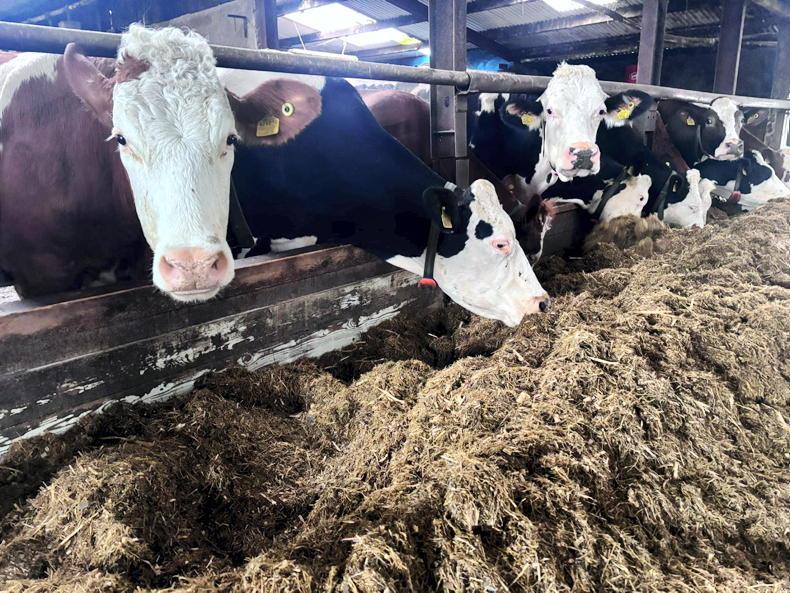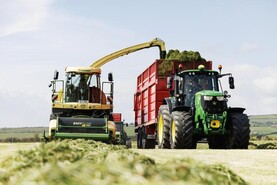The start of February brings with it a busier time on the farm, with the hope of spreading slurry on drier ground, the start of grass-measuring for the year and our spring batch of cows are due to start calving.
This is the second year we have moved to two calving batches in either the autumn (October and November) or spring (February and March). Previously cows calved from October to May.
The calving blocks have worked well on the farm, allowing all calving and calf areas to be washed and disinfected, lowering the risk of disease. In addition, it reduced workload over December and January, decreasing staff requirements during the Christmas period and creating a perfect opportunity for a week on the ski slopes.
Extending silage
At the beginning of this year, we estimated silage stocks at the current daily feeding rate would only keep us going until mid-March.
In an ideal world we would be grazing full-time at this stage, however, previous grazing years have shown us how weather and grazing conditions are not guaranteed.
Although we weighed up a few options, the best solution for the farm was to increase the level of blend fed through the wagon by an additional 1kg/head/day. This increased our overall feeding rate for the milking cows from 0.30kg/l to 0.33kg/l.
So why has the problem around silage stocks occurred and how are we going to fix it?
Firstly, I think the wet summer months resulted in poor grass utilisation, increasing the area of ground grazed and limiting the number of surplus bales that were harvested. For example, there were over 300 bales harvested in 2018 and only 45 bales in 2023.
Secondly, moving the calving profile of the herd to two blocks, with the largest proportion of animals calving in October, has resulted in more cows milking during the winter months and fewer cows being dry, increasing overall silage consumption.
Lastly, this is our first year feeding maize silage to the herd. My naivety led me to believe that adding maize silage into the wagon mix would reduce the amount of grass silage consumed. In practice, cows are currently consuming similar levels of grass silage as in previous years. To avoid the same happening around tight silage stocks next winter, we hope to harvest more grass this year and buy more maize.
We have also made further grazing infrastructure improvements to assist with efficient utilisation of grazing.
But, not everything is in our control and, like all farmers, I live in hope of a better summer.
Vaccinations
This week we plan to vaccinate all animals for Leptospirosis and IBR. Vaccinating has been delayed by two months this year, as we have had difficulty obtaining a salmonella vaccine and have been advised to proceed without it, as the local vets are unsure when stocks will arrive.
During my time in the Agri and Rural Affairs Committee within the Young Farmers’ Clubs of Ulster (YFCU), anti-microbial resistance was one of the main discussion points, with several events being held to raise awareness of the issue.
Whilst vaccines are an important tool to assist in the fight against antimicrobial resistance, with the best will in the world, farmers cannot vaccinate when the vaccines are not available.
In our own situation, the last sample of mastitis sent away to determine the pathogen causing the infection, took over a week for results to be confirmed – this delay can subsequently lead to an ineffective antibiotic being administered. Higher powers than individual farmers on the ground need to tackle these issues, if they really want to assist farmers in combating antimicrobial resistance.
Read more
New compound fertilisers available for protected urea
Dairy management: how much grass to give freshly calved cows
The start of February brings with it a busier time on the farm, with the hope of spreading slurry on drier ground, the start of grass-measuring for the year and our spring batch of cows are due to start calving.
This is the second year we have moved to two calving batches in either the autumn (October and November) or spring (February and March). Previously cows calved from October to May.
The calving blocks have worked well on the farm, allowing all calving and calf areas to be washed and disinfected, lowering the risk of disease. In addition, it reduced workload over December and January, decreasing staff requirements during the Christmas period and creating a perfect opportunity for a week on the ski slopes.
Extending silage
At the beginning of this year, we estimated silage stocks at the current daily feeding rate would only keep us going until mid-March.
In an ideal world we would be grazing full-time at this stage, however, previous grazing years have shown us how weather and grazing conditions are not guaranteed.
Although we weighed up a few options, the best solution for the farm was to increase the level of blend fed through the wagon by an additional 1kg/head/day. This increased our overall feeding rate for the milking cows from 0.30kg/l to 0.33kg/l.
So why has the problem around silage stocks occurred and how are we going to fix it?
Firstly, I think the wet summer months resulted in poor grass utilisation, increasing the area of ground grazed and limiting the number of surplus bales that were harvested. For example, there were over 300 bales harvested in 2018 and only 45 bales in 2023.
Secondly, moving the calving profile of the herd to two blocks, with the largest proportion of animals calving in October, has resulted in more cows milking during the winter months and fewer cows being dry, increasing overall silage consumption.
Lastly, this is our first year feeding maize silage to the herd. My naivety led me to believe that adding maize silage into the wagon mix would reduce the amount of grass silage consumed. In practice, cows are currently consuming similar levels of grass silage as in previous years. To avoid the same happening around tight silage stocks next winter, we hope to harvest more grass this year and buy more maize.
We have also made further grazing infrastructure improvements to assist with efficient utilisation of grazing.
But, not everything is in our control and, like all farmers, I live in hope of a better summer.
Vaccinations
This week we plan to vaccinate all animals for Leptospirosis and IBR. Vaccinating has been delayed by two months this year, as we have had difficulty obtaining a salmonella vaccine and have been advised to proceed without it, as the local vets are unsure when stocks will arrive.
During my time in the Agri and Rural Affairs Committee within the Young Farmers’ Clubs of Ulster (YFCU), anti-microbial resistance was one of the main discussion points, with several events being held to raise awareness of the issue.
Whilst vaccines are an important tool to assist in the fight against antimicrobial resistance, with the best will in the world, farmers cannot vaccinate when the vaccines are not available.
In our own situation, the last sample of mastitis sent away to determine the pathogen causing the infection, took over a week for results to be confirmed – this delay can subsequently lead to an ineffective antibiotic being administered. Higher powers than individual farmers on the ground need to tackle these issues, if they really want to assist farmers in combating antimicrobial resistance.
Read more
New compound fertilisers available for protected urea
Dairy management: how much grass to give freshly calved cows






 This is a subscriber-only article
This is a subscriber-only article











SHARING OPTIONS: